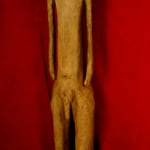Belanda Wooden Grave Marker, 18th Century CE - 20th Century CE
Wood
64
SUD.900 (LSO)
Further images
This impressive anthropomorphic sculpture was made by the Belanda people of Sudan. It comprises a small base – a section from a much larger trunk – supporting an elongated human...
This impressive anthropomorphic sculpture was made by the Belanda people of Sudan. It comprises a small base – a section from a much larger trunk – supporting an elongated human body with attenuated limbs and penis, a round head and a slightly angered expression due to raised brows and small, dark eyes. The lower end displays signs of having been interred. The wood is fine-grained and heavy. The overall impression of the piece is reminiscent of Zaramo and Nyamezi sculptures.
The Belanda are one of several closely affiliated groups (Bongo, Belanda, Sara) that moved from Chad in the 16th century to the grasslands area of southern Sudan. They are especially known for their grave markers – tall posts with anthropomorphic features – carved from mahogany which resists weathering and termites. The posts are awarded to worthy people, such as chiefs. Some examples bear specifics about the interred individual, such as notches that denote the number of large animals they killed. The posts become a focal point through which living descendants can contact the deceased, whose spirit will be with Loma (the creator god). Belanda pieces can be differentiated from Bongo versions owing to the more naturalistic appearance of the former.
The Bongo only honour males in this way, although the Belanda also put them up to women. The physical features are idealised, not portraits of the deceased. When buried, the flamboyance of the festivities must match the worthiness of the deceased, or else he will be unable to use his influence with Loma to improve the lot of his descendants. The posts were buried deeply into the burial mounds of prominent personages, and, if removed, were cut off about half way up to prevent damaging the sacred ground. The large posts are usually surrounded by a host of smaller figures that represent family members. Other artworks are associated with the altars hunters raise to Loma-Gubu, the antithesis of Loma, and who must be appeased by appropriate behaviour from the hunter and his wife.
This is a beautifully harmonious and well-carved piece of African art, and a credit to any good collection or sophisticated domestic setting.
The Belanda are one of several closely affiliated groups (Bongo, Belanda, Sara) that moved from Chad in the 16th century to the grasslands area of southern Sudan. They are especially known for their grave markers – tall posts with anthropomorphic features – carved from mahogany which resists weathering and termites. The posts are awarded to worthy people, such as chiefs. Some examples bear specifics about the interred individual, such as notches that denote the number of large animals they killed. The posts become a focal point through which living descendants can contact the deceased, whose spirit will be with Loma (the creator god). Belanda pieces can be differentiated from Bongo versions owing to the more naturalistic appearance of the former.
The Bongo only honour males in this way, although the Belanda also put them up to women. The physical features are idealised, not portraits of the deceased. When buried, the flamboyance of the festivities must match the worthiness of the deceased, or else he will be unable to use his influence with Loma to improve the lot of his descendants. The posts were buried deeply into the burial mounds of prominent personages, and, if removed, were cut off about half way up to prevent damaging the sacred ground. The large posts are usually surrounded by a host of smaller figures that represent family members. Other artworks are associated with the altars hunters raise to Loma-Gubu, the antithesis of Loma, and who must be appeased by appropriate behaviour from the hunter and his wife.
This is a beautifully harmonious and well-carved piece of African art, and a credit to any good collection or sophisticated domestic setting.





